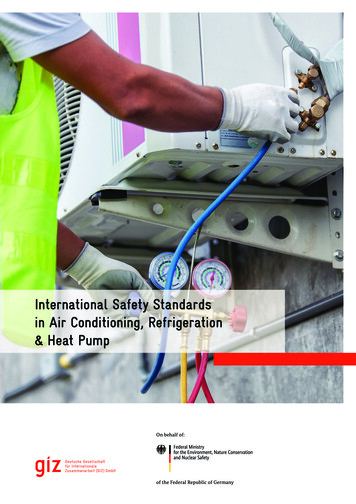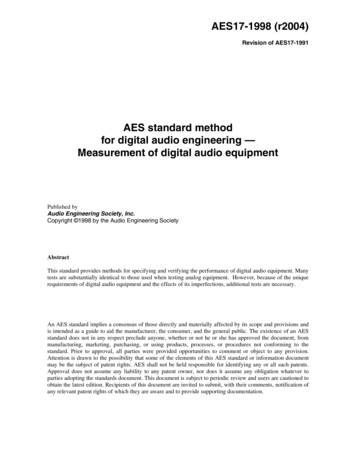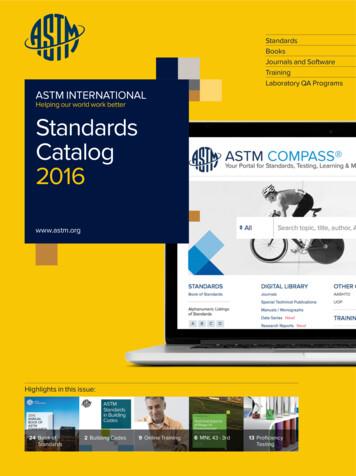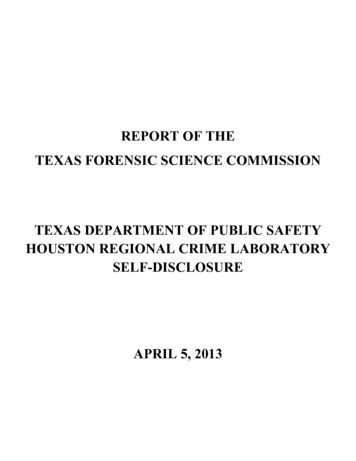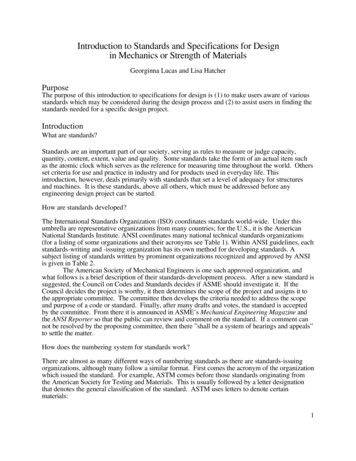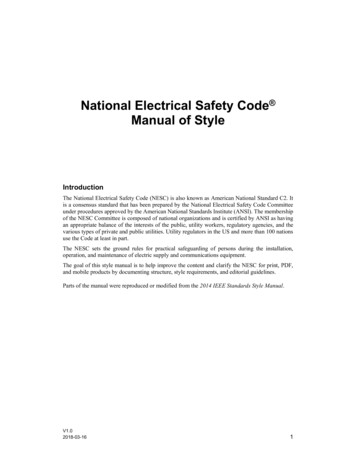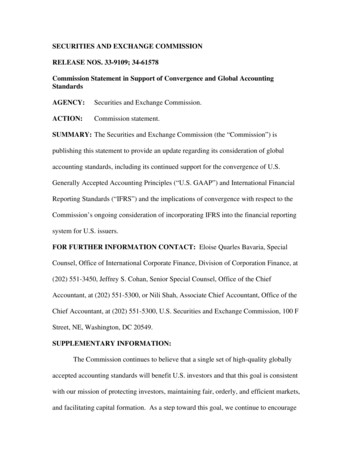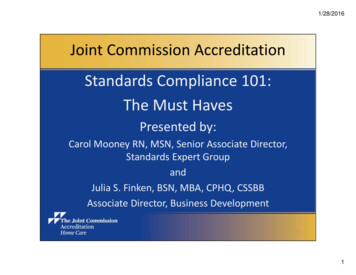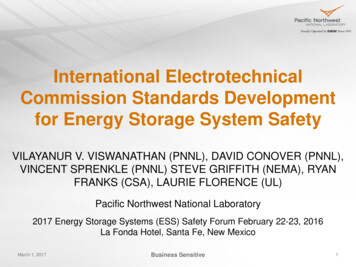
Transcription
International ElectrotechnicalCommission Standards Developmentfor Energy Storage System SafetyVILAYANUR V. VISWANATHAN (PNNL), DAVID CONOVER (PNNL),VINCENT SPRENKLE (PNNL) STEVE GRIFFITH (NEMA), RYANFRANKS (CSA), LAURIE FLORENCE (UL)Pacific Northwest National Laboratory2017 Energy Storage Systems (ESS) Safety Forum February 22-23, 2016La Fonda Hotel, Santa Fe, New MexicoMarch 1, 2017Business Sensitive1
OutlineWhat is IEC?How can you get involved?How does IEC work?Why is IEC relevant?What are the various ESS and Battery Safety Standards developed?IEC TC120 Energy Storage SystemDescription of overall effortFocus on safetyTC21/JWG105 Flow Battery safetyVarious TC21 efforts on cells and module safetyNext steps and visionMarch 1, 2017Business Sensitive2
What is International Electrotechnical Commission (IEC) Develops standards for “allelectrical, electronic and relatedtechnologies”IEC home page: www.iec.chExperts Management SystemCollaboration Tools SuiteMeeting Registration SystemVoting & CommentingNew Docs / MyNewDocsWeb ConferencingTechnical Information Services andSupport (tiss@iec.ch)Most of the text is from Slide from Damien Lee presentation at TC 120 meeting, 2013-1212, Frankfurt, Germany, with some information from http://www.iec.ch/about/?ref menu
IEC – how does it work?“One of three global sister organizations (IEC, ISO, ITU)”IEC cooperates with ISO or ITU via joint committees to ensure compatibilityEach IEC standard is developed by working groups in a technical committee (TC)Each country has its own technical advisory group (TAG) associated with a TCThe US TAG is overseen by NEMAAny individual can join the US TAG by paying annual dues ( 250/TAG)Each Tag has a Secretary and Head of DelegationAt the IEC level, there is a Secretary and Chairperson.The working group leads are assigned by consensus among member countriesThe working group develops committee drafts (CDs) that are put up for commentsEach member country submits its comments through its TAG.The working group lead consolidates comments and decides which are acceptedThe CD is then subject to voting (CDV) by all member countriesBased on consensus, the draft is then published as a standards or rejected forfurther revisionsThis process can take up to 5 yearsMarch 1, 2017Business Sensitive4
IEC – Relevance and next stepsInternational standards can become trade barriersAdversely impact US interestsProvide entry into global markets for products from other countries thatmay not comply with US standards/metricsIEC makes concerted effort to avoid doing duplicative workThe DOE-sponsored performance protocol was used as basis of WG2TC120 work on ESS PerformanceEfforts ongoing to include latest revision of Protocol into TC120 (WG3 –examples of various applications in the Appendix)Poor adoption rate in the US for IEC standardsWe continue to rely on US codes and standardsBy actively engaging in IEC TC WGs, the US can ensure its interests arewell representedMarch 1, 2017Business Sensitive5
IEC TC 120TC120 Develops an ESS standard for performance, gridintegration, safety and environmentScope “Electrical Energy Storage (EES) Systems are becomingkey components of the grid. TC 120 describes and definessystem aspects of EES systems which are grid connected ANDoperated as both an energy source and sink with respect to thegrid.” Grid includes utility, commercial/industrial and residential.Principles:No duplication of existing IEC TC activitiesEstablish liaisons with appropriate TCs Perform gap analysis todetermine gaps in ESS storage standardsConsider storage as a black box – don’t go inside - concept adoptedfrom DOE-OE protocol.March 1, 2017Business Sensitive6
TC120WG1 – Terms and definitionsdefine terms applicable to electrical energy storage systemsWG2 – Unit parameters and test methodsUnit parameters – energy capacity, input/output power, SOC rangePerformance test – accuracy, round trip efficiency, response timeCategorizing the EES systems applications – peak shaving/shifting, Ancillary service(frequency regulation), renewable integrationWG3 – Planning and installation of ESSElectrical properties of grid operationMonitoring and measurementOperation and maintenanceWG4 – EnvironmentalEnsure environmental hazards are reduced to tolerable level for utility,commercial/industrial or residential use.General requirements include normative documents for the harmful materials in theESS, recycling and greenhouse effects. Specific requirements include documents forelectrical, mechanical and surrounding conditions.WG5 – SafetyImplement safety measures and study potential risks in relation to the technologies usedand their locations.March 1, 2017Business SensitivePrepare normative documents dealingwith risks, recommendations to mitigate bad7
TC120 StructureTC120SecretaryWG1ChairpersonWG2WG3Member country TAGs provide input to WGsThe US TAG is administered by NEMAMarch 1, 2017Business SensitiveWG4WG5Gap Analysis WG to identify focusareas. Input provided to all WGs8
TC120 LiaisionsLiaisons with other IEC TCsTC8:Systems aspects for electrical energy supplyTC21: Secondary cells and batteriesSC21A : Secondary cells & batteries containing alkaline or othernon-acid electrolytesTC22: Power electronic systems and equipmentTC57: Power systems management & associated informationexchangeTC 82: Solar photovoltaic energy systemsTC 88: Wind turbinesTC 105: Fuel cell technologiesTC 117: Solar thermal electric plantsMarch 1, 2017Business Sensitive9
IEC TC120 SafetyDraft Technical Specification (DTS) ready for votingSeveral safety related terms added to Terms and Definitions:Explosion hazardFailure modeFire hazardProtective subsystemProtective measureReasonably foreseeable misuseRiskRisk analysisRisk assessmentRisk evaluationSafetyThermal hazardTolerable riskMarch 1, 2017Business Sensitive10
IEC TC120 Safety - ApproachIdentify hazardsPerform risk analysisDevelop risk mitigation measuresMarch 1, 2017Business Sensitive11
IEC TC120 Safety – identify hazardsElectrical – burns, fires and injuries from arc flash, explosion fromstatic electricity build-up in the presence of flammable substancesMechanical – ejected parts from equipment hitting the individual.Results in abrasions, lacerations, contusions.Explosion – deflagration and detonationPhysical such as Boiling Liquid Expanding Vapor Explosion leads to tankruptureChemical from thermal runaway of exothermic reactions, fuel/air mixtures,dust particles/air – the latter two need an ignition sourceElectromagnetic – can cause electrical arcsFireHigh temperatureChemicalUnsuitable working conditionsMarch 1, 2017Business Sensitive12
TC 120 – Information needed for ESS risk assessmentGeneral characteristics – Battery type, rated power &energy, rated life,safety measures, operating parameters, known hazardsSpecific characteristics associated with various types of energy storageType of grid– transmission, distribution, commercial, industrial, residential,islandedApplication type – peak shaving, load levelling, frequency regulation,renewable firming, backupLocation of storage – outdoor or indoor, enclosed or not, undergroundUnintended access by people, moving objects, extreme weather, lightning,floodingUnattended operationUnintentional islandingMarch 1, 2017Business Sensitive13
TC120 – Risk analysisHazard impact considered across the life cycle (cradle to grave)Poor protection devices – cannot interrupt high currentIneffective malfunction detectionSystem control malfunctionAux subsystem malfunctionProper safety policies in placeAssessment of risk from serious hazards such as fire, explosion, highspeed projectiles, toxic gas releaseMaintenanceSystem level – FMEA, FMECA, FTA, HAZOPMarch 1, 2017Business Sensitive14
TC120 – Risk mitigationAfter identification of risk, consider if risk is tolerable. If not, mitigateControl and monitoringPreventionMitigationPlant Emergency ResponseArea Emergency ResponsePreventive measuresAgainst damage to nearby locationsESS should have a safety related system independent and separated from ESScontrol subsystemAgainst damage to workers and other residentsElectrical hazardsMarch 1, 2017Guard against accidental contact by fending, guarding etc.Appropriate PPEProtection measures against arc flash and shockDetection of Earth fault, over/under voltage, current and temperatureLightning protectionElectrostatic dissipationFusingBusiness Sensitive15
TC 120 – Risk mitigation continuedPreventive measuresAgainst damage to workers and other residentsMechanical hazardsEnclosure structural requirementsSafety interlock to control access to an otherwise moving partStop motion of a moving partStabilize the equipmentExplosionPrevention – reduce explosive atmospheres, avoid ignition sourceProtection – isolation, venting, suppression and containmentElectric, magnetic and electromagnetic fieldsIEC 61000 series relevant to immunity against these hazardsSingle component EMC immunity confirmedSystem interactions should be considered along with EMC disturbances in theenvironmentOther hazards – fire, temperature, chemical, unsuitable work environment,hazardous emissions and leaksOver current protection designMarch 1, 2017Business Sensitive16
TC 120 – Risk mitigation continuedSystem disconnection and shutdownRegular maintenanceSubsystem/component malfunctionExternal constraintsSystem upgradesEnd of service lifeCircuit opening done at different pointsPCCAt transformer levelSwitching deviceStorage subsystemAuxiliary subsystemGrid-disconnected state – ESS disconnected from gridStopped state – DC storage not connected to PCS – the systemshutdown command places ESS in this statePart of Auxiliary subsystem remains poweredBusinessSensitive of the ESS need to be shutdown17Partial disconnection – when onlypartsMarch 1, 2017
TC 120 – Risk mitigation continuedSafety design should be incorporated cradle to grave – as newcomponents introduced or application changesNot possible to do certain safety tests on entire system. Hencecomponent testing critical.Testing to validate subsystem compatibility and safetyAuxiliary system malfunctionESS control system malfunctionESS internal and external communication malfunctionGuidelines and manualsMarch 1, 2017Business Sensitive18
TC 120 – main risks of batteriesCell failure due to overcharge, overdischarge, external or internalshort-circuit, temperature rise, loss of containment.Propagation to neighboring cellsInsufficient heat dissipationExternal mechanical effectsAccidental heat flux exposureCell ventingAll of the above lead to thermal runaway resulting inCell explosionChemicals emissionsRelease of hot, flammable, corrosive gas, liquidFireMarch 1, 2017Business Sensitive19
Flow Battery Safety IEC TC21 JWG7 21/901/CDIEC 62932-2-2Lots of similarities with IEC TC120Several normative references citedRisk analysis procedure described (For FMEA and FTA, IEC 60812and 61025 used as guidance)Safety requirements and protective measuresRisk information – includes safety data sheer and user manualElectrical hazardsShockShort circuitsGround faultsGas hazardsVentilation – natural, forcedFluid hazardsAcid or alkaliEnsure good sealingMaterial containing fluid stableMarch 1, 2017Leakage detection – shutdown pumps when leak detectedSensitiveSpecific information related toBusinessemergencymeasures20
Flow Battery Safety IEC TC21 JWG7 21/901/CDIEC 62932-2-2Mechanical hazardsOperational hazardsImproper integration of subcomponentsStart operation done only after safeguards in place with suitable interlocks forproper sequence during startEmergency shutdown – triggered by protection system or manualRemote monitoring and controlSuitable protection devices to detect abnormal situations and intitate emergencystopProper nameplate and safety informationTransport – national and international regulation. For example, fluidsshall be emptied out of stacks to avoid short circuitRegular inspectionVerification tests for safetyExternal short circuitTanks and stacks have sufficient electrical resistance to avoid earth grounding faultStandard operation of charge or dischargeEmergency stopMarch 1, 2017Business Sensitive21
IEC TC 21 62485-1 Safety requirements forsecondary batteries and battery installations –Part 1: general safety informationNominal voltage up to 1500 V DCAddresses basic safety requirements for parts 2, 3 and 4Part 2 - safety needs for stationary batteries with aqueous electrolytePart 3 – safety needs for Traction batteries with aqueous electrolytePart 4 – safety needs for batteries used in portable applicationsNormative referencesIEC 60364-4-41 Protection for safety for electrical installations of buildingsIEC 61429:1996 A11:1998 Marking with international recycling symbol ISO 70001135Terms and definitionsTechnical characteristics of various batteriesApplication typeTelecommunicationsUPSPV solarForkliftMiningMarch 1, 2017Ships, railwaysBusiness Sensitive22
IEC TC 21 62485-1 Safety requirements forsecondary batteries and battery installations –Part 1: general safety informationSwitch mode operation – One power source feeds load, and another chargesbattery. When DC1 fails, battery connected to loadParallel mode operation – DC power source, battery and load connected in parallelSuperimposed AC ripple current during charge or discharge causes additionalheatingMeasures for protection against shockDisconnection and separationCommissioning - Delivery condition, electrolyte fillingVoltage, current, SOC range and temperature limitsExternal short circuitExplosion hazardsElectrolyte hazardsMarking, labelingTransport and storageDisposal and environmental aspectsMarch 1, 2017Business Sensitive23
Example of IEC work on DC cells and batteriesTC21/JWG82 – Secondary Cells and Batteries for Renewable EnergyStorage. General Requirements and Methods of Test – Part 2: On-gridapplicationsMethods of test for performance and enduranceAccelerated degradation using pulsed cycling (fr
01.03.2017 · Risk analysis procedure described (For FMEA and FTA, IEC 60812 and 61025 used as guidance) Safety requirements and protective measures Risk information – includes safety data sheer and user manual Electrical hazards Shock Short circuits Ground faults Gas hazards Ventilation – natural, forced Fluid hazards Acid or alkali Ensure good sealing Material containing fluid stable Leakage
